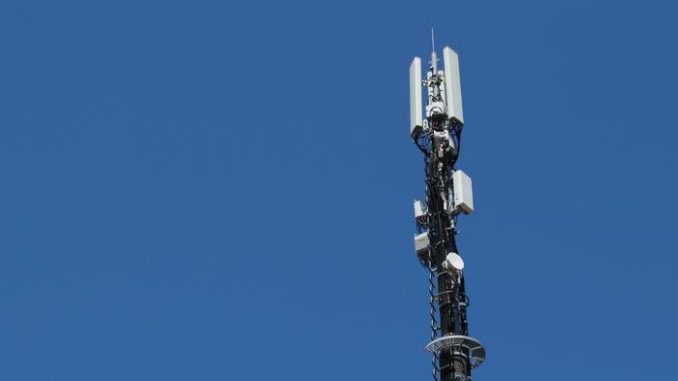
Switzerland has received its first 5G antenna. In Oerlikon, Sunrise showed what it can do. The Telco wants to replace existing ADSL / VDSL offerings with the new mobile radio standard – but not all hurdles have been eliminated yet.
Just over half a year after Sunrise set a world record in the transmission of data in the 5G frequency range, the Telko doubled at the end of June. Sunrise has commissioned the first 5G antenna in Switzerland.
“The world record still took place in a test lab,” Sunrise CEO Olaf Swantee told the visitors. The new antenna is the first, which, however, was switched live under real conditions. It is located about 200 meters from the Sunrise headquarters in Oerlikon. It is an existing antenna on the grounds of the EWZ, which has now been upgraded to spark in 5G.
And what does Sunrise transmit with Switzerland’s first 5G antenna? Netflix in UHD! The Telko had set up a total of three 4k TVs and three tablets. In addition to Netflix, they also showed content from Youtube and from a Sunrise TV box.

The 5G modem from Huawei. (Source: Network Media)
The connection between the devices and the antenna was a Huawei 5G CPE modem. The Chinese manufacturer first showed the device at the Mobile World Congress 2018 in Barcelona. According to Swantee, the 5G modem will probably go into mass production in the first quarter of 2019.
The device used in the test was “fresh from the factory and still warm,” said Elmar Grasser, CTO of Sunrise. The device is about the size of a kettle and was directly connected to the 5G antenna.
First the consumer, then the IoT
The fact that the test setup focused strongly on the needs of consumers was probably no coincidence. Although Sunrise in connection with 5G talks a lot about the Internet of Things (IoT), autonomous vehicles and smart industry. However, Sunrise wants to make the first steps in the new frequency ranges in the consumer environment.
“5G for the People” is the motto. It should start in 2020. The new mobile standard will initially bring higher efficiency, said Swantee. Although traffic is doubling almost every year according to the CEO, Sunrise intends to be able to operate with the existing sites for the next 6 years. This is also important because in urban areas, in particular, an expansion is hardly feasible, said Swantee.

(from left) Wang Haitao, CEO of Huawei Switzerland, Olaf Swantee, CEO, and Elmar Grasser, CTO of Sunrise. (Source: Network Media)
The higher data throughput should also bring a replacement for ADSL / VDSL offers. In particular, where there is no fiber-to-the-home (FTTH), the Telco could make its private and business customers Fiber-to-the-Air (FTTA) – a wireless Internet offer, comparable to fiber-optic speeds offers.
Also conceivable is a back-up Internet about 5G. For example, in the event that the regular wired Internet fails. FTTA could also be used for temporary peak performance. “For example, if the World Cup would take place here in Switzerland or if Federer plays again,” said Swantee.
NIS regulations could disrupt Sunrise’s plans
However, there is still a potential “showstopper”: the NIS regulation. The abbreviation stands for non-ionizing radiation, also known as electrosmog. In Switzerland, there are high requirements in this regard, which is allowed. Sunrise also talks about a NIS regime in this context. This prevents the expansion of the antenna network.
“We do not need NIS regulations that are ten times more stringent than what the World Health Organization (WHO) thinks is right,” said Swantee. “We need regulations that are 3 times as strict!”
As late as March 2018, the Council of States had decided not to adjust the 20-year-old limit values. Without a change, however, a 5G introduction would only be possible on a limited scale. And also at 4G bottlenecks are expected soon.
“This must be an economic concern, not just a telco interest,” agreed CTO Grasser.
What it is about
Grasser then explained to the audience what exactly will change with 5G. The new standard mainly used two new frequency bands. These are in the 3.5 GHz and 700 megahertz ranges.
The 3.5 gigahertz spectrum is suitable for high transfer rates and speeds, Grasser said. A transmission rate of 400 to 500 megabits per second is realistic in this spectrum.
The 700-megahertz range is rather used for the area-wide supply. In addition, they bring in further into the building and there also ensure a good coverage. Speeds of 150 to 200 megabits per second are conceivable in this area.

A difference of 6 months: The 5G module, which also hangs on the antenna (left) and the equipment that was used in the laboratory experiment in December. (Source: Network Media)
So 5G is not much faster than 4G in the 700 megahertz spectrum. But thanks to two new technologies used at 5G, the efficiency is significantly higher and the latency much lower.
New is about Massive MiMo. The same frequency is broadcast over many antennas at the same time. Thanks to beamforming, the radio beams should also follow the user. The base station identifies the most efficient connection to the user and can thus reduce interference to other data connections.